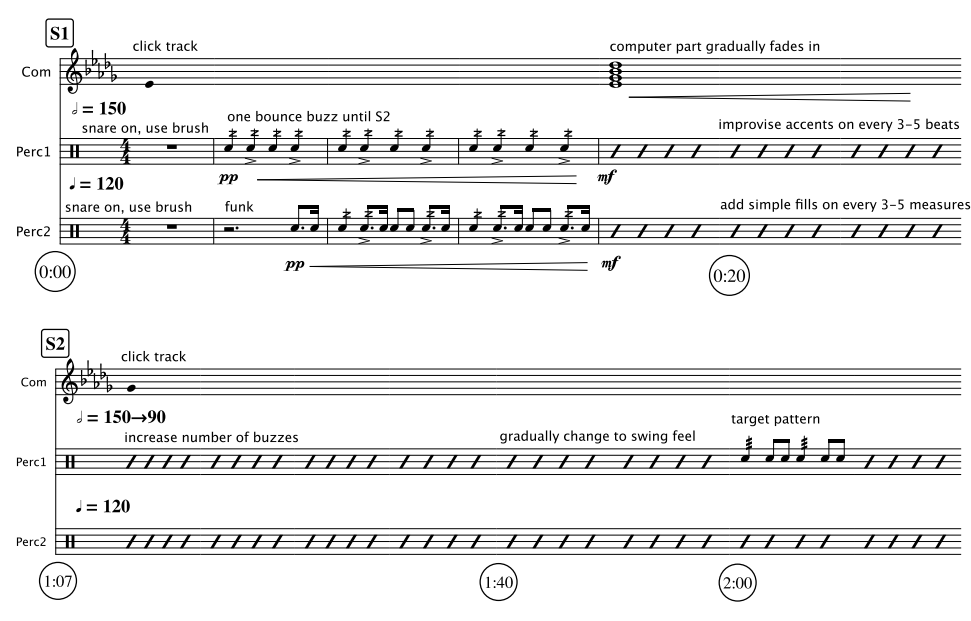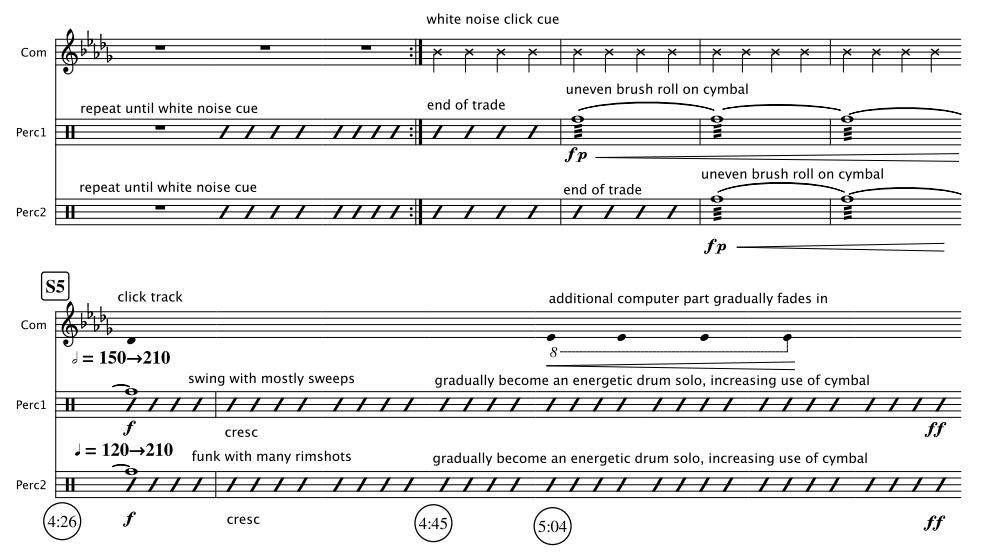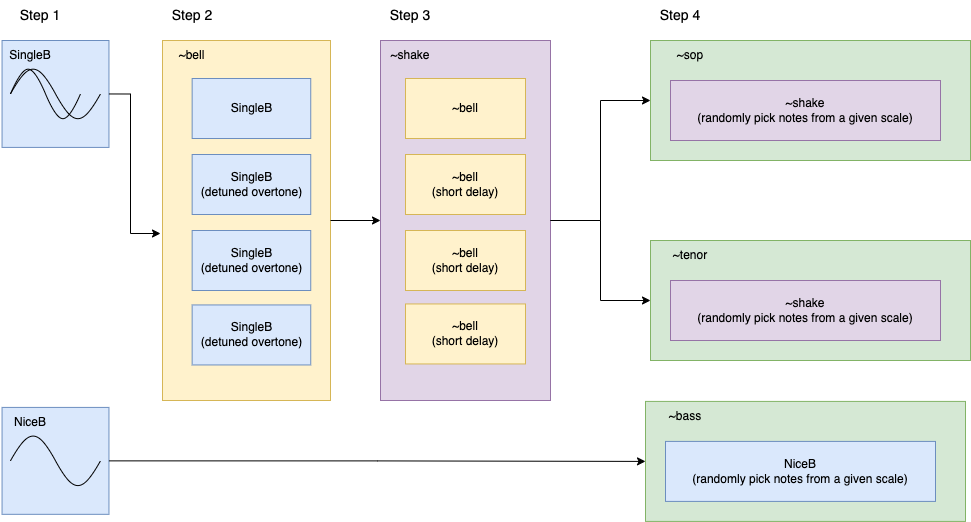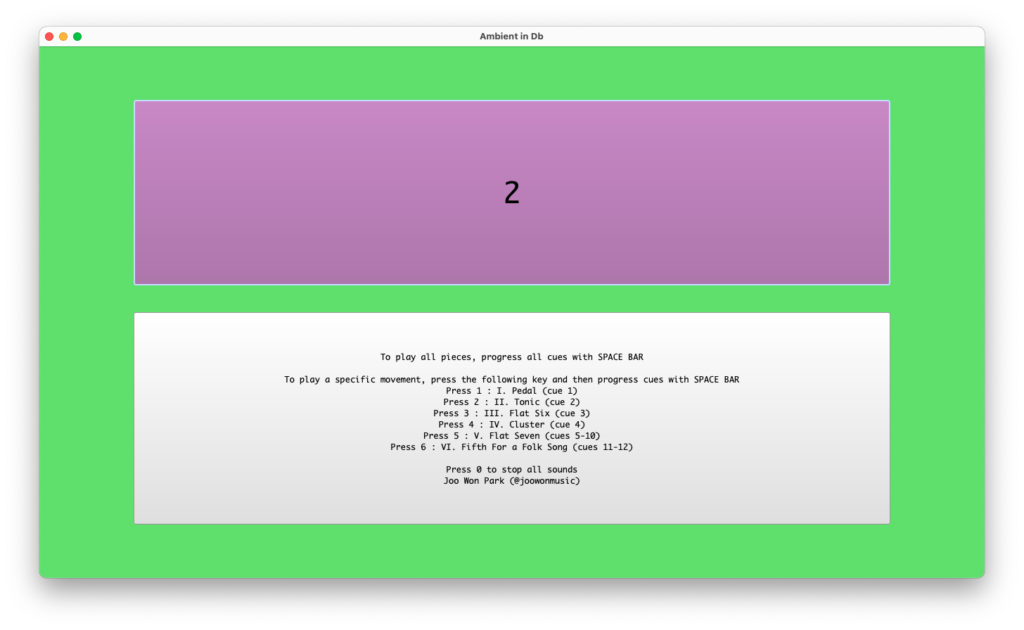Program Notes
JNNJ was commissioned and premiered by Hunter Brown and Louis Pino in 2016. The piece is inspired by the life and dynamics of my family. The title is a combination of the first letters of mom, dad, and two sons.
Technical Needs
- One computer with a DAW or Max. A Logic Pro X session is provided, but any DAW will work. The tape part can also be played with the provided Max patch.
- Stereo sound system
- Two headphones for click tracks
- An audio Interface with four separate outputs
- TapeL.aif should be routed to output 1, connected to the left speaker
- TapeR.aif should be routed to output 2, connected to the right speaker
- ClickTrackL.aif should be routed to output 3, connected to Perc1’s click track
- ClickTrackR.aif should be routed to output 4, connected to Perc2’s click track
Performance Needs
- Two percussionists with a snare drum and a large cymbal for each performer.
- Both performers use brushes for the entire piece.
- Perc1 stands close to the left speaker, and Perc2 stands close to the right speaker
Performance Instruction

- Each performer gets his/her own click track. The click tracks run in various tempi and over the entire piece. Each performer should follow his/her own click track.
- Interpret the score like a jazz chart. Improvise in the notated style (funk and swing).
- Pay attention to the pitch of the click track to hear the section changes.
- Section-specific notes:
- S1: The tape part will fade in at around the 20-second mark.
- S2: Perc1 transforms the rhythmic pattern to a swing (indicated as “target rhythm”) while slowing down.
- S3: Perc2 transforms the rhythmic pattern to a more energetic and busy funk rhythm while slowing down. Listen for the white noise cue for the next section.
- S4: Both Perc1 and Perc2 trade off solo while speeding up. The trade offs will gradually overlap with each other. Listen for the white noise cues to play uneven brush sweep on cymbals.
- S5: Both parts will get significantly faster. When the tempo becomes too fast, freely improvise with great energy. Increase the use of cymbals throughout the section.
- S6: Both Perc1 and Perc2 play energetic cymbal improvisation while slowing down. Accompany the tape part after the click track stops. At the end of the fixed part (7:00), create a quiet, windy sound by swinging the brush in the air.
Composing Click Track
A computer is excellent at doing precise tasks. It is a good tool for creating music that needs precise control. I can ask a computer to make a click track from 120BPM to 150BPM in 2 minutes, and it will do so without a hitch. In JNNJ, I used the precision of a computer to create a percussion duet featuring continuously changing tempo.

JNNJ requires each percussionist to follow their assigned click track. The tempi of the click tracks change constantly, asynchronously with each other. The performers are asked to follow the click track while improvising according to the score. To realize this idea, I made a click track with distinct features.
- The click track gradually but precisely changes at a given duration. The performers listening to the click track should feel comfortable adjusting the tempo while reading the score.
- To aurally cue the section changes, the pitch of the click changes in the click track. The notes are in harmony with the fixed media part.
- The click tracks play unpitched count-in beats for the parts where a sudden or fast change is needed.
- The performers also read the click tracks in their score. The unstemmed quarter notes in the computer part indicate the pitch of the click tracks. Most of the fixed media part is described in words in the score.

The click tracks and fixed media parts are coded and rendered in SuperCollider. The audience does not get to hear it, but I think the most distinguishing feature of JNNJ is the click track. The fixed media part is simple in terms of timbre, so that the audience can focus on the duel of percussionists marching in different beats.
Refinement
The palindromic approach to tempo change (one part goes from X BPM to Y BPM while others go from Y BPM to X BPM at the same time) was previously explored in a fixed media piece called Cross Rhythms. Prior to that piece, I also explored palindromic timbre in a few other fixed media pieces. The third movement of Sound Mobile sounds exactly the same when played forward and backward. Multiple and varied attempts at expressing an idea through sound are necessary for refining and redefining.


